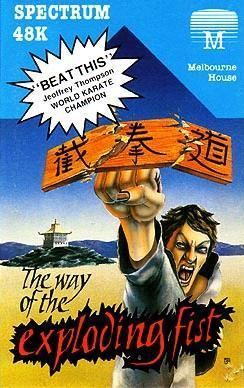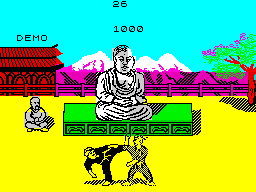7.4 /10 1 Votes7.4
Developer Krome Studios Melbourne | 3.7/5 Classic Retro Games Initial release date 1985 Designer Gregg Barnett | |||||||||||||||||||||||||||||||||
 | ||||||||||||||||||||||||||||||||||
Mode(s) Single player; Two-player Awards Best Amstrad Game, Best Sports Game Publishers Krome Studios Melbourne, Spinnaker Software, Ricochet Similar Krome Studios Melbourne games, Fighting games | ||||||||||||||||||||||||||||||||||
C64 longplay the way of the exploding fist hq
The Way of the Exploding Fist is a 1985 fighting game by Gregg Barnett of Beam Software. Originally developed on the Commodore 64 and published in June 1985 by Melbourne House, ports were made for Amstrad CPC, ZX Spectrum, BBC Micro, Acorn Electron and Commodore 16. It was one of the first games to include realistic graphics and movements and borrows heavily from the Data East arcade game Karate Champ which was released the previous year. An NES version was developed by Beam Software but it was never released.
Contents
- C64 longplay the way of the exploding fist hq
- Retrogames gameplay the way of the exploding fist
- Gameplay
- Production
- Reception
- Sequels
- Critical reaction
- References

The name of the game is probably a play on Bruce Lee's fighting system Jeet Kune Do, which can be translated to "Way of the Intercepting Fist".

Karate champion Jeoffrey Thompson was signed to promote the game but was not sufficiently well known to have the game named after him.

Retrogames gameplay the way of the exploding fist
Gameplay

The player takes part in a series of one-on-one karate matches, all overseen by a wise old expert who appears somewhere in the background. Once the player defeats an opponent they move up to the next stage and a more difficult adversary. Fights were not won using the energy-bar style found in modern fighting games but instead the player needed to get two complete yin-yangs. Any move that connected with the opponent would end the round; a loosely timed or borderline kick or punch would obtain half a yin-yang icon, while a well-executed move would obtain a full icon. Two complete icons ended the bout and progressed to the next level.

This system of scoring, known as shobu nihon kumite, is used in real life in many traditional styles of karate. A half yin-yang represents a waza-ari (a committed but not decisive technique) and a full yin-yang represents an ippon score (full point, decisive finishing blow).

Control works using joystick or direction keys and a "fire" key. You can achieve up to 18 different movements, including jumping kick, roundhouse kick and a variety of punches and kicks, high and low. There are also defensive moves including blocks and somersaults. There are 16 'regular' movements - initiated by the 8 possible joystick directions, with button pressed and 8 without the button pressed. The 17th move, used against the bulls mentioned below, is made by first pulling the joystick downward, then 'rolling it' forward to the down/forward (forward being whichever way the player's fighter is facing) diagonal, The character will first crouch (as achieved by moving joystick downward) then proceed with a low punch from the crouched position. The 18th move is done by initiating a roundhouse kick (simultaneously pressing button whilst moving the joystick left if the fighter is facing right, and vice versa, but instead of completing the kick, if the button is released midway, the fighter will instead spin 180 degrees and face the other direction.
The game features a variety of backgrounds against which the fighting takes place.
After completing a number of progressively harder stages, the player would be charged at by a bull in a (often short-lived) bonus-style round. (This was not present in the ZX Spectrum version and some of the early Commodore 64 versions.) The player must knock the bull out with a single hit. The bonus round mirrors the feats of Mas Oyama, a renowned karate expert who purportedly killed bulls with a single strike.
Production
Before creating The Way of the Exploding Fist, designer Gregg Barnett converted The Hobbit and Sherlock, two adventures from Beam Software, to the Commodore 64.
The Commodore 64 version uses over 600 sprite images to animate the player's movements.
The game's soundtrack is based on the 1952 orchestral piece, Dance of the Yao People.
Reception
The game was voted game of the year at the Golden Joystick Awards, with Melbourne House picking up Best Software House.
Sequels
There were two sequels: Fist 2: The Legend Continues (1986) and Exploding Fist +. Of these two, Fist 2 is not a fighting game, but a scrolling action game with 1-on-1 fighting elements. Exploding Fist +, on the other hand, returns to the style of the first game. It features combat with three characters, an idea followed from International Karate +, though in this case it is possible for players to control the three characters simultaneously.
Critical reaction
The Commodore 64 version was a Sizzler in Zzap!64 magazine, scoring 93% overall. The games sound and graphics were acclaimed.
The ZX Spectrum version was placed at number 67 in the "Your Sinclair official top 100", with reviewers praising the visceral sound effects.
The game went on to become the best selling ZX Spectrum game, the best selling Amstrad CPC game, and the best selling game of the month overall in the Gallup charts.
